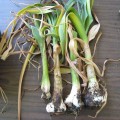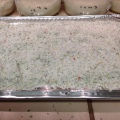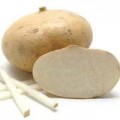Easy to grow – virtually foolproof, chives are not bothered by diseases or pests. They make great borders to a walkway or flower garden, and are useful in the kitchen – both the flowers and the stems.
Botanical Information
Taxonomy
Allium schoenoprasum – other alliums include onions, garlic, leeks and shallots. Alliums are part of Liliaceae, the Lily Family.
History
Physical Description
Perennial, warm season herb with lavender-pink flowers in June; normally 6-8″ tall, but may grow as tall as 18 inches; grow in clumps, similar to grass, about 6-8″ wide. Roots are bulb clumps, which do not descend far into the ground
Varieties & Cultivars
Categories or Types of [plantname]
Colors Available
Varieties (link to ../category/cultivars/tag/[plantname])
Growth Requirements
Climate & Temperature Requirements
Air Temperature
- Chives love hot temps
- Germination temp for chives: 60-70°F
- Hardy to frost and light freezes
Soil Temperature
Humidity
Day Length or Light Requirements
Chives grow in full sun to part-shade
Site Conditions Favored
Soil Requirements
Soil Texture
Chives prefer moist, well-drained soil, but they an be found growing wild in dry, rocky places in northeastern US and Canada, as well as northern Europe.
pH: 5.5-7.0
Nutrient Requirements
Chives are considered light feeders
Propagation
Methods of propagation
Seed
- very easy to grow from seed
- days to germination: 10-14 days
- start seeds 31-56 days before your last frost date
Division
Every 3-years in mid-May divide plants into clumps of 6 bulbs.
Cuttings
don’t think it’s possible to root cuttings – division is the way to go
Transplanting or Potting Up
- transplant into the garden at 21-42 days, or at your last frost date
Seed Saving
Planting Out
Bed Prep & Soil Amendments
Bed Spacing
space plants 6″ apart
Row Spacing
chives can be planted in rows 5-8″ apart in rows 12″ apart
Planting Depth
1/4″ to 1/2″ deep
Alternative Bed Methods
Container Gardening
Chives thrive in containers on the kitchen windowsill
Routine Cultivation & Maintenance
Water Requirements
average
Fertilization Recommendations
no side dressings needed
Mulching & Weeding
Pinching or Pruning & Dividing
- Once the plant reaches 6″ tall, cut some of the blades down to 2″ above the ground. This will encourage plant production
- Regular picking of spent flowers encourages repeat blooming
- Divide the clumps every few years
- Dig a clump and pot it up for your windowsill when it starts getting cold out
Support
Winterizing
- Cut them back after flowering in the fall or early winter so new shoots come up in the spring
Companion Planting
Helpful Companions
- Carrots
- Celery
- Grape
- Peas
- Rose
- Tomato
Harmful Companions
- Beans
- Peas?
Companion to..
- Celery (deters aphids)
- Lettuce (deters aphids)
- Peas (deters aphids)
- roses (prevents black spot)
- anything that suffers from Japanese beetles
- cucumbers, melons, squash (prevents mildew)
- apples (prevents scab)
Pests, Diseases & Problems
Common Pests
none – as a matter of a fact, they are thought to be a deterrent to aphids and Japanese beetles
Common Diseases
none – and they are reputed to thwart black spot, mildew and scab
Symptoms
Whole Plant
Leaves
Stem/Trunk
Flowers
Fruit
Roots
Harvesting & Storage
Edible Parts of the Plant
- Flowers have a mild onion flavor
- Green stems have a mild onion flavor
Yield
Days to Harvest / Harvest Timing
- Days to maturity: 50 days (whether or not transplanted)
- Flowers: chives start flowering in June; harvest when they are just beginning to open up
- Stems: shoots come up in early spring; harvest the greens anytime after they reach 6″
Harvest Methods
Flowers: harvest in the morning, after the dew has dried, but before the sun is on the plant; snip the flower head off, or the whole blade, if you are using the green, too
Stems: harvest in the morning after the dew has dried; cut near the base of the greenery, so new shoots will emerge
Storage of harvest
Chives taste best fresh or frozen, but can also be dried.
Fresh
Flowers: if left on stem, stand them in a glass of water, otherwise, store them in a single layer on damp paper towels or ziploc, in a cool, dark place, or the fridge
Stems: can be stored upright in a vase or glass of water, keep in a cool spot or refrigerate
Canned
uhh…don’t bother
Frozen
Chives taste excellent after freezing. Chop finely then freeze in a thin layer in a ziploc; break off as needed, and return to freezer
Vinegar
Make a pretty lavender-colored, mildly onion-flavored vinegar by putting a few chive stems, with their flowers still attached, into white distilled vinegar. Make sure to completely cover the flower by a good inch or two. These make good gifts.
Dried
- Flowers: Chive flowers don’t dry well
- Stems:
- Dry whole chive stems by tying them in small bunches to be hung upside down in a warm, dry, dark place. Try not to crush them or cut them until ready to use – store them whole.
- Chopped: alternate 1″ layers of kosher salt with chives in a glass dish, packing down each layer with a spoon; use these chives, as you would fresh, in any dish; salt also takes on the chive flavor
Cooking
Nutritional Benefits & Values
Toxicity
Cooking
Preparation
Flowers: dust off to remove dirt & insects
Stems: just dust off lightly to remove dirt & debris
Cooking Methods
Flowers: use whole composite flower for garnishment or break apart the florets to sprinkle on food
Recipes (link to …/category/recipes/tag/[plantname])
Chive flowers are great additions to:
- salads
- cooked vegetables
- casseroles
- cheese dishes
- eggs
- potatoes
- cream cheese
Chive stems can be used raw or cooked in egg dishes:
- salads
- soups
- sauces
- vegetable dishes
- fish dishes
- scrambled eggs
- quiche
- omelettes
Resources
Information for this article was taken from these sources. (link to …/category/resources/tag/[plantname])




